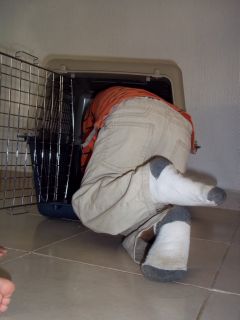 |
| This says: "I have time and money to waste ..." |
I live in a community which by many people would be considered "poor" or at least (even in Mexico) significantly below average. I've estimated that the average household income in our neighborhood would probably be a bit over $7000 CDN, annually. (Based on the cut off for mortgage requirements for buying a home.) From my experience, the cost of living is about 1/2 of that in Canada, so by Canadian standards we could say it's equivalent to about an annual income of around $14,500. By all the standards, it's well below the Canadian poverty line , which is about $30,000, I believe. (The Canadian "poverty line" is a joke anyway, since it has no relation to poverty; it's measured as the bottom quarter of household income, not by basic needs or standards of living, but that's a different story.)
 |
| Too much money? Too much to eat? (A papaya) |
The average household income in Mexico is about $10,000 USD per year, according the CIA Word Factbook. So it's even noticeably below this country's average.
So, my community is officially poor. Yet, at the same time, I walked out of my house this morning to take my son to school and saw a papaya splattered all over the neighbour's house and sidewalk, left there to rot.
I go for walks every day, and every day I see new graffiti on the walls. I see garbage bags ripped open by dogs with half-eaten take-out meals strewn all over the sidewalk. I've been to countless parties where people pick a few things off their plate and throw the rest away.
On one level it's annoying that the first three habits make my community dirty, but that's a different issue. The issue here is that people are absolutely wasteful.
I think our definition of poverty has been very, very skewed. If we define poverty in terms of material needs - food, clothing and shelter in their most basic and necessary sense - then I've never seen poverty. I know it exists somewhere, but I've never seen it. I'd guess that people who REALLY were poor would absolutely never consider destroying any kind of food, just for fun, even to prove a point. I'd guess that knowing what hunger really is like, from experience (which I don't, and, as far as I know, no one I know does) would simply eliminate that possibility that you could throw away food. I'd guess that you'd never consider wasting what little money you had on a can of spray paint to graffiti your neighbour's wall.
Yet, all of these these problems are usually associated with poverty. It's strange, isn't it? I'd say the problem is abundance and idleness, not poverty.
The person I know who is closest to poverty does not consider himself poor. While his living conditions are substandard (by our standards), he does not feel he is lacking anything in life, and would never ask anyone for anything. He works hard, every day of his life.
Yet the "poor" people in my neighborhood can throw away food, give their kids money to buy spray paint, etc., etc. Then they complain about the government and big companies.
While it's less visually obvious, I'd say the problem is just as big in Canada. And we like to talk about the 99% and all of that. People like to talk about poverty, yet I see so much complete wastefulness, that I can't take it seriously.
My wife and I believe in helping the poor. And we do. We help the poorest people we know every time we have a chance. But as long as people have enough money and idle time to waste food and vandalize their neighbourhood, I don't feel sorry for them.





































